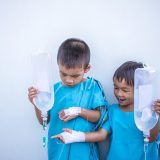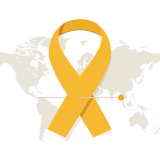Treating Retinoblastoma at Pediatric Cancer Centers
Pediatric retinoblastoma is a rare form of kids’ eye cancer that can be life threatening if it’s not treated quickly enough. Like all forms of child cancer, retinoblastoma is typically treated in specialized pediatric cancer centers. These cancer centers may stand alone or be part of large hospitals. Pediatric cancer centers offer a wealth of support for patients and their families, in addition to treatment. Who Is Treated at Pediatric Cancer Centers? Children from birth to age 18 or even 21 may be treated at pediatric cancer centers. Children with any form of cancer may receive treatments of all different types. Some of the children that are treated at cancer centers are treated on an outpatient basis, while others may have their own rooms and stay for an extended period of time. Lively Themes and Designs The children and families that utilize pediatric cancer centers are typically worried about the diagnosis, the upcoming treatments, and the potential prognosis after treatment. To take their minds off of the situation and let kids be kids as much as possible, most cancer centers are bright and lively, with toys and games in main areas. Even individual rooms may be colorful and have fun drawings and other child-friendly attributes. Play Therapy To help kids cope with their feelings and work through complex emotions, some cancer centers integrate creative play with other types of treatment. Doctors and therapists may bring props that will get kids laughing and encourage them to talk about their fears and thoughts. This type of therapy has shown to be effective for some patients. Cutting Edge Treatments Most pediatric cancer centers are supported by the Children’s Oncology Groupand the National Cancer Institute. This international network of support allows pediatric cancer centers to have access to some of the most cutting edge research, technology, and clinical trials. For pediatric retinoblastoma patients, this may increase the odds that vision will be retained while also combating the cancer. A Network of Peers One of the things that many families of children with pediatric retinoblastoma find most helpful about pediatric cancer centers is the network of peers that the center puts families in touch with. The other children and families present at the center are dealing with many of the same struggles, worries, and issues. It can be reassuring and helpful to have someone to talk to that is going through the same life changes and trying some of the same coping techniques. While dealing with a pediatric retinoblastoma diagnosis can be tough, having top quality care and support from a pediatric cancer center can improve the prognosis and provide peace of...
read moreNew Hope for Detecting Retinoblastoma in Low-Income Families
When it comes to detecting eye issues such as pediatric retinoblastoma early, low income children tend to be at a disadvantage compared to children born into affluence. The disparity between affluent children and low income children born in underdeveloped countries is even worse. Fortunately, an innovative app is helping to detect the rare cancer – as well as other eye conditions – and saving the vision and lives of lower income children around the world. Obstacles to Eye Care for Low Income Children An app that can be used to detect pediatric retinoblastoma and other serious eye conditions in children is effective in getting around a few of the obstacles to early detection that children in lower income families face. Transportation issues and doctor visit costs may prevent lower income families from seeing an eye care professional. Since the app is free, parents can use the app to determine whether a trip to a specialist is needed before footing the bill. About the Retinoblastoma App The app that can be used to detect pediatric retinoblastoma is called CRADLE. The app works by analyzing pictures in a smartphone and comparing the eyes in the pictures to many other pictures of eyes in order to assess health. The app was developed by a professor named Bryan Shaw after his son received a late diagnosis of pediatric retinoblastoma that cost him an eye. Smartphone Use and Lower Income Families According to Pew Research Center, smartphone use among U.S. families earning $30,000 or less per year skyrocketed to 64 percent as of January 2017. Smartphone ownership in developing countries has also been rising quickly, with many countries approaching the same percentages of smartphone owners as developed nations. This widespread and growing smartphone use helps to put apps like CRADLE into the hands of those who need them most. How the App Can Help the Disadvantaged In the United States, the cure rate for pediatric retinoblastoma is about 94 percent, but many children in lower income families lose their vision or their eyes due to later detection of the deadly disease. In some developing nations, the cure rate is less than 30 percent. The CRADLE app can help with early detection that can save lives and help to mitigate the need for invasive or intensive treatment that damages eyes and vision. By using the free app to analyze pictures regularly, parents around the world can spot potential eye problems in very early stages. This can give disadvantaged families the time needed to seek medical treatment, particularly in remote areas where it may not be easy to get to a doctor. Get the CRADLE App You can now find the CRADLE app in both iTunes and Google...
read moreA Look into Children’s Eye Development
There may not be a more special moment for new parents than the very first time that their baby looks up, locks eyes with their parent, and smiles. It’s the kind of moment that stays with parents for the rest of their lives, and the kind of moment that they wish and hope that their children are able to experience for themselves when they have children of their own. If that doesn’t happen right out of the gate – or even within the first week or so of your child’s birth – don’t get nervous and don’t be afraid. Children’s eyes are not fully developed at the time of birth. However, it’s important that you do everything you can to protect them from environmental factors and take steps to spot potential problems that can reduce their vision. Get a Second Opinion When You Need to It’s important to trust your doctors. Your pediatrician will likely provide you with a host of important lessons, tips, and helpful hints to really assist you as new parents in making sure that your children develop just as happy and as healthy as humanly possible. A significant portion of these talks should revolve around protecting and encouraging their eyesight development. However, if you feel at any point that you might want a second opinion, don’t hesitate to get one. Pediatric retinoblastoma is a highly aggressive disease, and every day counts toward getting the right treatment. Run Through Critical Tests Almost immediately after your baby is born, the delivery doctor (and later your pediatrician) is going to put your baby through a battery of relatively simple and noninvasive tests. These tests are going to focus on looking for congenital cataracts or more serious eyesight conditions like neonatal eye problems or pediatric retinoblastoma (a very rare but serious type of children’s eye cancer). Let your doctor run through these tests but make sure that they keep you informed every step of the way, and trust in their ability to develop appropriate action plans to resolve any issues that may arise. Follow Up with Regular Eye Tests Yes, you are going to be exhausted for the first couple of years of your child’s life, but you have to make sure that you don’t miss out on any necessary tests, examinations, or regular checkups. Be sure that development is right on track and that your child’s eyesight and health isn’t at risk. Regular vision checkups (every three months or so at first, and then twice a year until they are two or three is probably a good baseline) will help you to catch serious issues like pediatric retinoblastoma that can move very quickly and aggressively. Understand Regular Development Milestones While infants’ eyesight may develop at different rates, there are some milestones that can be used to benchmark normal development: Most newborns have peripheral vision Focus of up to three feet develops within the first weeks By two months, most babies can focus on and track objects Distance vision develops by four months old Color vision is usually fully developed by about four months old Depth perception, focus, and convergence may continue to develop through age seven If there are any delays in normal vision development or if issues with the eyes are identified, it is important to see a doctor as soon as possible. Spotting issues and eye conditions may help to preserve your child’s vision and potentially his or her...
read morePediatric Retinoblastoma: How Screening Saves Lives
For little Parker Abbott, a 20 month old infant from Waxahachie, Texas, life has already been filled with tremendous challenges. Parker suffers from bilateral retinoblastoma, a rare form of cancer that forms in children’s eyes. There are approximately 700 cases reported annually, with around a quarter of them being bilateral, which means that cancer forms on both retinas. The majority of these cases form in children under 5 years of age, and are caused by irregularities in the development of special retinal cells called retinoblasts. For children like Parker, such a diagnosis is a prescription for months of arduous treatments and surgeries. Many children may lose an eye to the disease, or tragically lose their battle entirely. As with all cancer cases, early observation and treatment is vital to improving the survival odds of a patient. The Importance of Screening In the past, conditions such as pediatric retinoblastoma have all too often slipped by the notice of doctors who have performed only cursory eye exams on children, rather than the scrupulous screenings required to spot many hidden, serious problems. Thankfully, this position is beginning to change as the medical community wakes up to the real risk involved in not carefully screening children for these maladies. The eye is a very complex and subtle biological machine. It can appear to be working at a very high level, but all the while be masking some kind of serious flaw or defect. Most of the time, these issues will just involve vision problems. On rare occasions, however, they can prove to be a lot more serious. Regular screening by a trained professional is absolutely vital, especially in the first five years of a child’s life. Modern Technologies New medical tools are being developed that can help diagnose illnesses such as retinoblastoma at very early stages, including digital photography tools developed by researchers at Harvard and Baylor Universities. MRI scans, ultrasounds and bone scans can also be used to detect a tumour. If a problem is discovered, there are a number of established treatments and promising clinical techniques to combat a retinoblastoma. Optometric physicians have all the tools at their disposal to detect this illness early and to start a child on an immediate treatment program. In the modern age, there is no excuse for a child not to receive a comprehensive eye exam from a trained professional, or indeed for that professional not to recognize any potential future problems. The Fight for Fairness For Parker Abbott, hope remains that he can overcome his terrible burden without losing his vision, or indeed his life. For many other individuals and families, no such optimism exists. The best they can hope for is that others do not have to endure the same loss that they have, and that no more children have to slip through the cracks due to a diagnosable and treatable disease. If you or a family member has suffered loss of vision, loss of an eye, or death from a pediatric retinoblastoma that could and should have been diagnosed earlier, please do not hesitate to contact us. It is only through meticulous care and accountability that we will ever succeed in defeating this terrible ailment and protecting all of our...
read moreFrom the Desk of Bill Ruffier: A Retinoblastoma Case Study
Bill Ruffier of Dellecker, Wilson, King, McKenna, Ruffier, & Sos has dedicated his career to fighting for the rights of children and families who have been devastated by pediatric retinoblastoma malpractice. Today, we’ll discuss a case that sadly represents many of the scenarios that occur in this realm: a pediatrician who neglected his duties, and consequently failed to diagnose the condition when all the warning signs were present. Please note that for the privacy of the client and defendant, personal details of the story have been changed. A Seemingly Normal Life Nadia and Omar Koury lived life just like any other family. After the birth of their first child Isaac, they sought out Dr. Griffin, a trusted and recommended pediatrician in Philadelphia. The Kourys took Isaac to all of his scheduled checkups. According to the pediatrician, he was in perfect health. However, when Isaac was two years and two months old, his parents noticed something that their pediatrician never did. Isaac’s left eye seemed to be stationary, failing to move or function the way his right eye did. The Kourys took Isaac to Dr. Griffin, who immediately referred them to a pediatric ophthalmologist who specializes in medical and surgical eye issues in children. That same day, they visited the ophthalmologist, who immediately diagnosed Isaac with pediatric retinoblastoma. A Devastating Diagnosis As pediatric retinoblastoma is a very aggressive form of cancer, the tumor took up nearly 75% of Isaac’s left eye. His retina was completely detached, leaving him blind in the affected eye. The tumor had spread to the sclera, or the white part of the eye. The family discussed and debated treatment options with their specialist. However, the diagnosis came too late: Isaac lost his eye to the cancer. The Legal Process Begins Fast forward nearly 10 years, and the Koury family finally found a lawyer who was equipped to take the case. Bill Ruffier and the team at Dellecker, Wilson, King, McKenna, Ruffier, & Sos immediately went to work. The team discovered photographs of Isaac when he was just 10 months old, showing one of the most telltale signs of pediatric retinoblastoma: leukocoria. In photos taken with a flash, Isaac’s left eye was white, while the other eye was normal. This revealed that Isaac’s pediatric retinoblastoma was diagnosable by his pediatrician for at least 16 months before he was actually diagnosed. Failing to Perform the Job During the deposition, Ruffier asked about the red reflex exams that Dr. Griffin was required to perform during Isaac’s Well Child visits, under requirements by the American Academy of Pediatricians. The requirements stated that the lights in the exam room must be dimmed for the ophthalmoscope to properly detect issues. When asked why Dr. Griffin failed to dim the lights, he responded with the untrue statement that young children have wide irises, making it unnecessary to dim the lights. A Lifetime of Challenges Fortunately, DWKMR&S was able to win the case for the Koury family, successfully proving that Dr. Griffin’s failed to follow his medical obligations, which put Isaac in serious danger and caused him to lose his eye. Unfortunately, Isaac faces a lifetime of challenges. As a teenager now, he experiences severe shame and embarrassment from his glass eye. When he’s older, he’ll have difficulty performing everyday tasks like driving. He’ll be restricted from a number of careers due to his lack of depth perception. A Call to Action for Families This case is not isolated. We urge families to be vigilant when it comes to identifying abnormalities like leukocoria, and to never hesitate to seek a second opinion when having...
read moreSeptember Is Childhood Cancer Awareness Month
No parent wants to hear the words, “Your child is sick,” from the pediatrician. Unfortunately, every two minutes, a child is diagnosed with pediatric cancer and life for that child and their family dramatically changes. That’s why every September, we aim to raise awareness on behalf of the kids, families and communities affected by life-altering conditions like retinoblastoma. Today, thanks to the hard work of doctors, volunteers and those dedicated to finding a cure, 4 out of every 5 children diagnosed with cancer will survive 5 or more years. Their commitment and perseverance has almost halved mortality rates of certain cancers, and we are closer every day to finding a cure to the #1 disease-related killer of children in the US. Even if you or a loved one are not directly involved with cancer, there is still a lot you can do this month to help. What Can You Do? The good news is that plenty of foundations make raising awareness a simple and enjoyable thing, no matter your age or schedule. We’ve put together a list of some charities dedicated to helping affected children, teens, and their families, so you can get involved. St. Baldrick’s Foundation Saint Baldrick’s Foundation is a volunteer organization wholly dedicated to finding a cure for children’s cancer. They have raised over 200 million dollars for cancer research in 27 countries world-wide. Through their website, you can get involved in your community, find videos to share on social media, leave a donation, or even learn how to start your own fundraiser this September. The American Childhood Cancer Organization The American Childhood Cancer Organization (ACCO) is another group leading the way in support for patients and families. You can visit their online shop where you can purchase items to help raise money and awareness, or purchase specially-designed resources geared towards helping those battling cancer themselves. The best thing about the ACCO is that, via their website, you can get involved directly with groups in your local area that fundraise and provide support. The Children’s Cancer Research Fund The Children’s Cancer Research Fund is a revolutionary group that has been advancing how pediatric cancer is treated since 1981. Whether it’s your child, a child you know, or even if you want to just get involved, their website is a great resource for practical information on how to help. With amazing organizations and volunteers working tirelessly, hopefully one day we’ll be able to eradicate childhood cancer for good. So this month, tie on a gold ribbon and help raise awareness for children across the globe. Together we can help find a...
read more





















